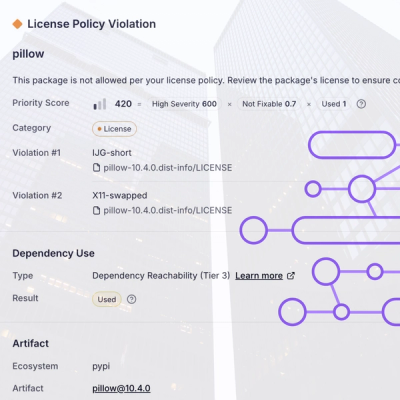
Research
/Security News
Critical Vulnerability in NestJS Devtools: Localhost RCE via Sandbox Escape
A flawed sandbox in @nestjs/devtools-integration lets attackers run code on your machine via CSRF, leading to full Remote Code Execution (RCE).
.. image:: https://readthedocs.org/projects/django-auth-ldap/badge/?version=latest :target: https://django-auth-ldap.readthedocs.io/en/latest/
.. image:: https://img.shields.io/pypi/v/django-auth-ldap.svg :target: https://pypi.org/project/django-auth-ldap/
.. image:: https://github.com/django-auth-ldap/django-auth-ldap/workflows/Test/badge.svg :target: https://github.com/django-auth-ldap/django-auth-ldap/workflows/Test/badge.svg
.. image:: https://img.shields.io/pypi/l/django-auth-ldap.svg :target: https://raw.githubusercontent.com/django-auth-ldap/django-auth-ldap/master/LICENSE
This is a Django authentication backend that authenticates against an LDAP service. Configuration can be as simple as a single distinguished name template, but there are many rich configuration options for working with users, groups, and permissions.
.. _python-ldap: https://pypi.org/project/python-ldap/
Install the package with pip:
.. code-block:: sh
$ pip install django-auth-ldap
It requires python-ldap_ >= 3.1. You'll need the OpenLDAP_ libraries and
headers available on your system.
To use the auth backend in a Django project, add
'django_auth_ldap.backend.LDAPBackend' to AUTHENTICATION_BACKENDS. Do
not add anything to INSTALLED_APPS.
.. code-block:: python
AUTHENTICATION_BACKENDS = [
'django_auth_ldap.backend.LDAPBackend',
]
LDAPBackend should work with custom user models, but it does assume that a
database is present.
.. note::
``LDAPBackend`` does not inherit from ``ModelBackend``. It is possible to
use ``LDAPBackend`` exclusively by configuring it to draw group membership
from the LDAP server. However, if you would like to assign permissions to
individual users or add users to groups within Django, you'll need to have
both backends installed:
.. code-block:: python
AUTHENTICATION_BACKENDS = [
'django_auth_ldap.backend.LDAPBackend',
'django.contrib.auth.backends.ModelBackend',
]
.. _OpenLDAP: https://www.openldap.org/
Here is a complete example configuration from settings.py that exercises
nearly all of the features. In this example, we're authenticating against a
global pool of users in the directory, but we have a special area set aside for
Django groups (ou=django,ou=groups,dc=example,dc=com). Remember that most
of this is optional if you just need simple authentication. Some default
settings and arguments are included for completeness.
.. code-block:: python
import ldap
from django_auth_ldap.config import LDAPSearch, GroupOfNamesType
# Baseline configuration.
AUTH_LDAP_SERVER_URI = 'ldap://ldap.example.com'
AUTH_LDAP_BIND_DN = 'cn=django-agent,dc=example,dc=com'
AUTH_LDAP_BIND_PASSWORD = 'phlebotinum'
AUTH_LDAP_USER_SEARCH = LDAPSearch(
'ou=users,dc=example,dc=com',
ldap.SCOPE_SUBTREE,
'(uid=%(user)s)',
)
# Or:
# AUTH_LDAP_USER_DN_TEMPLATE = 'uid=%(user)s,ou=users,dc=example,dc=com'
# Set up the basic group parameters.
AUTH_LDAP_GROUP_SEARCH = LDAPSearch(
'ou=django,ou=groups,dc=example,dc=com',
ldap.SCOPE_SUBTREE,
'(objectClass=groupOfNames)',
)
AUTH_LDAP_GROUP_TYPE = GroupOfNamesType(name_attr='cn')
# Simple group restrictions
AUTH_LDAP_REQUIRE_GROUP = 'cn=enabled,ou=django,ou=groups,dc=example,dc=com'
AUTH_LDAP_DENY_GROUP = 'cn=disabled,ou=django,ou=groups,dc=example,dc=com'
# Populate the Django user from the LDAP directory.
AUTH_LDAP_USER_ATTR_MAP = {
'first_name': 'givenName',
'last_name': 'sn',
'email': 'mail',
}
AUTH_LDAP_USER_FLAGS_BY_GROUP = {
'is_active': 'cn=active,ou=django,ou=groups,dc=example,dc=com',
'is_staff': 'cn=staff,ou=django,ou=groups,dc=example,dc=com',
'is_superuser': 'cn=superuser,ou=django,ou=groups,dc=example,dc=com',
}
# This is the default, but I like to be explicit.
AUTH_LDAP_ALWAYS_UPDATE_USER = True
# Use LDAP group membership to calculate group permissions.
AUTH_LDAP_FIND_GROUP_PERMS = True
# Cache distinguished names and group memberships for an hour to minimize
# LDAP traffic.
AUTH_LDAP_CACHE_TIMEOUT = 3600
# Keep ModelBackend around for per-user permissions and maybe a local
# superuser.
AUTHENTICATION_BACKENDS = (
'django_auth_ldap.backend.LDAPBackend',
'django.contrib.auth.backends.ModelBackend',
)
If you'd like to contribute, the best approach is to send a well-formed pull request, complete with tests and documentation. Pull requests should be focused: trying to do more than one thing in a single request will make it more difficult to process.
If you have a bug or feature request you can try logging an issue_.
There's no harm in creating an issue and then submitting a pull request to resolve it. This can be a good way to start a conversation and can serve as an anchor point.
.. _logging an issue: https://github.com/django-auth-ldap/django-auth-ldap/issues
FAQs
Django LDAP authentication backend
We found that django-auth-ldap demonstrated a healthy version release cadence and project activity because the last version was released less than a year ago. It has 3 open source maintainers collaborating on the project.
Did you know?

Socket for GitHub automatically highlights issues in each pull request and monitors the health of all your open source dependencies. Discover the contents of your packages and block harmful activity before you install or update your dependencies.

Research
/Security News
A flawed sandbox in @nestjs/devtools-integration lets attackers run code on your machine via CSRF, leading to full Remote Code Execution (RCE).

Product
Customize license detection with Socket’s new license overlays: gain control, reduce noise, and handle edge cases with precision.

Product
Socket now supports Rust and Cargo, offering package search for all users and experimental SBOM generation for enterprise projects.